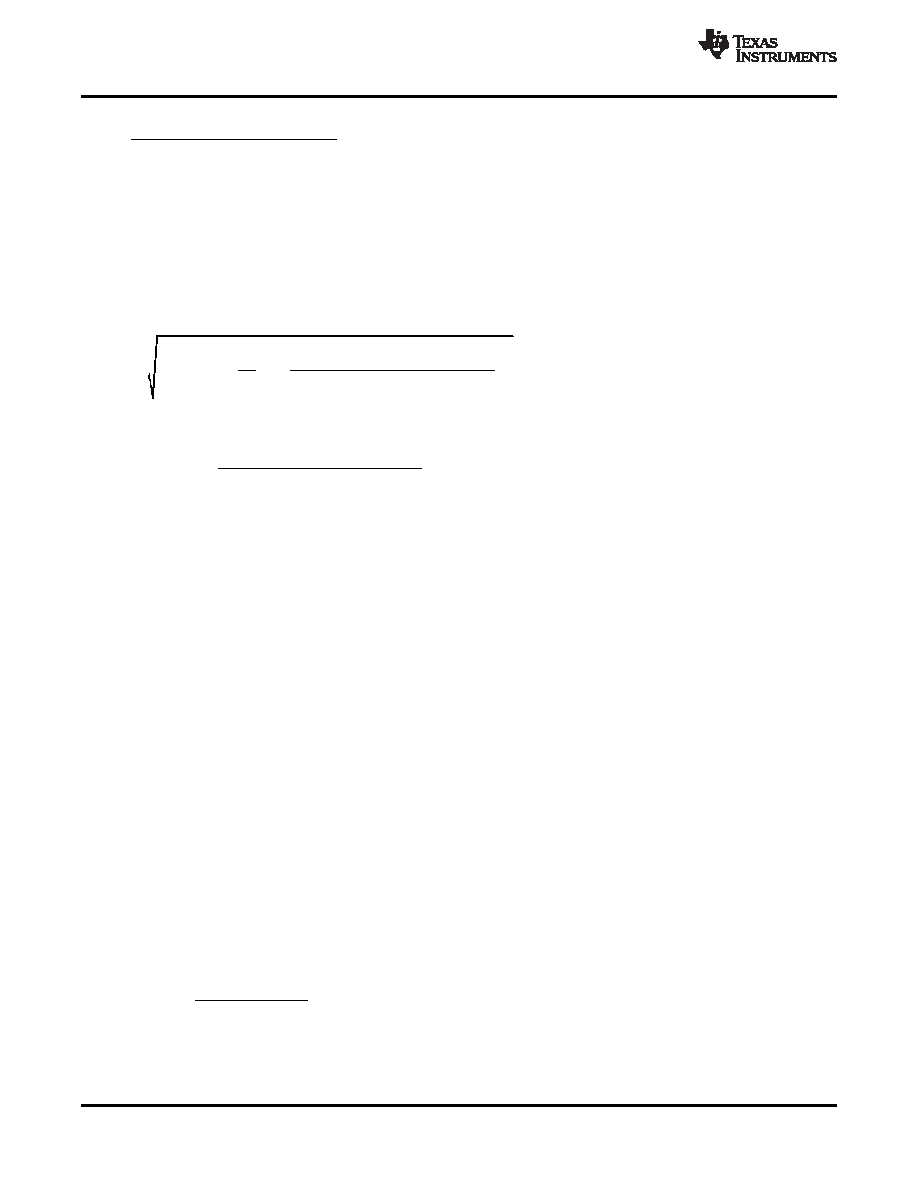- 您現在的位置:買賣IC網 > PDF目錄98283 > TPS54331DG4 (TEXAS INSTRUMENTS INC) 2 A SWITCHING REGULATOR, 684 kHz SWITCHING FREQ-MAX, PDSO8 PDF資料下載
參數資料
| 型號: | TPS54331DG4 |
| 廠商: | TEXAS INSTRUMENTS INC |
| 元件分類: | 穩(wěn)壓器 |
| 英文描述: | 2 A SWITCHING REGULATOR, 684 kHz SWITCHING FREQ-MAX, PDSO8 |
| 封裝: | GREEN, PLASTIC, MS-012AA, SOIC-8 |
| 文件頁數: | 4/27頁 |
| 文件大小: | 794K |
| 代理商: | TPS54331DG4 |
第1頁第2頁第3頁當前第4頁第5頁第6頁第7頁第8頁第9頁第10頁第11頁第12頁第13頁第14頁第15頁第16頁第17頁第18頁第19頁第20頁第21頁第22頁第23頁第24頁第25頁第26頁第27頁

(
)
OUT(MAX)
IN(MAX)
OUT
MIN
IN(MAX)
IND
OUT
SW
V
L
=
V
K
I
F
-
(
) 2
OUT
IN(MAX)
OUT
2
L(RMS)
OUT(MAX)
IN(MAX)
OUT
SW
V
1
I
=
I
+
12
V
L
F
0.8
-
÷
÷
è
(
)
OUT
IN(MAX)
OUT
L(PK)
OUT(MAX)
IN(MAX)
OUT
SW
V
I
= I
+
1.6
V
L
F
-
)
2
/(
1
max
_
min
_
CO
O
F
R
C
=
p
ú
ù
ê
é
+
-
=
E S R
O
S W
L P P
O P P
R
C
F
D
I
V
4
)
5
.
0
(
SLVS839C – JULY 2008 – REVISED MARCH 2010
www.ti.com
(8)
KIND is a coefficient that represents the amount of inductor ripple current relative to the maximum output current.
In general, this value is at the discretion of the designer; however, the following guidelines may be used. For
designs using low ESR output capacitors such as ceramics, a value as high as KIND = 0.3 may be used. When
using higher ESR output capacitors, KIND = 0.2 yields better results.
For this design example, use KIND = 0.3 and the minimum inductor value is calculated to be 5.7mH. For this
design, a large value was chosen: 6.8 mH.
For the output filter inductor, it is important that the RMS current and saturation current ratings not be exceeded.
The RMS inductor current can be found from Equation 9
(9)
and the peak inductor current can be determined with Equation 10
(10)
For this design, the RMS inductor current is 3.01 A and the peak inductor current is 3.47 A. The chosen inductor
is a Sumida CDRH103-6R8 6.8 mH. It has a saturation current rating of 3.84 A and an RMS current rating of 3.60
A, meeting these requirements. Smaller or larger inductor values can be used depending on the amount of ripple
current the designer wishes to allow so long as the other design requirements are met. Larger value inductors
will have lower ac current and result in lower output voltage ripple, while smaller inductor values will increase ac
current and output voltage ripple. In general, inductor values for use with the TPS54331 are in the range of
6.8 mH to 47mH.
Capacitor Selection
The important design factors for the output capacitor are dc voltage rating, ripple current rating, and equivalent
series resistance (ESR). The dc voltage and ripple current ratings cannot be exceeded. The ESR is important
because along with the inductor current it determines the amount of output ripple voltage. The actual value of the
output capacitor is not critical, but some practical limits do exist. Consider the relationship between the desired
closed loop crossover frequency of the design and LC corner frequency of the output filter. In general, it is
desirable to keep the closed loop crossover frequency at less than 1/5 of the switching frequency. With high
switching frequencies such as the 570-kHz frequency of this design, internal circuit limitations of the TPS54331
limit the practical maximum crossover frequency to about 25 kHz. In general, the closed loop crossover
frequency should be higher than the corner frequency determined by the load impedance and the output
capacitor. This limits the minimum capacitor value for the output filter to:
(11)
Where RO is the output load impedance (VO/IO) and fCO is the desired crossover frequency. For a desired
maximum crossover of 25 kHz the minimum value for the output capacitor is around 5.8mF. This may not satisfy
the output ripple voltage requirement. The output ripple voltage consists of two components; the voltage change
due to the charge and discharge of the output filter capacitance and the voltage change due to the ripple current
times the ESR of the output filter capacitor. The output ripple voltage can be estimated by:
(12)
Where NC is the number of output capacitors in parallel.
12
Copyright 2008–2010, Texas Instruments Incorporated
Product Folder Link(s): TPS54331
相關PDF資料 |
PDF描述 |
|---|---|
| TPS54350MPWPREP | 7.2 A SWITCHING REGULATOR, 700 kHz SWITCHING FREQ-MAX, PDSO16 |
| TPS54372PWP | 3 A SWITCHING REGULATOR, 762 kHz SWITCHING FREQ-MAX, PDSO20 |
| TPS54418RTER | 6.4 A SWITCHING REGULATOR, 2000 kHz SWITCHING FREQ-MAX, PQCC16 |
| TPS54426PWP | 7.5 A SWITCHING REGULATOR, 700 kHz SWITCHING FREQ-MAX, PDSO14 |
| TPS54429PWP | 0.01 A SWITCHING REGULATOR, 700 kHz SWITCHING FREQ-MAX, PDSO14 |
相關代理商/技術參數 |
參數描述 |
|---|---|
| TPS54331DR | 功能描述:直流/直流開關轉換器 3A 28V In Step Down SWIFT DC/DC Cnvrtr RoHS:否 制造商:STMicroelectronics 最大輸入電壓:4.5 V 開關頻率:1.5 MHz 輸出電壓:4.6 V 輸出電流:250 mA 輸出端數量:2 最大工作溫度:+ 85 C 安裝風格:SMD/SMT |
| TPS54331DRG4 | 功能描述:直流/直流開關轉換器 26V,3A DC-DC Converter RoHS:否 制造商:STMicroelectronics 最大輸入電壓:4.5 V 開關頻率:1.5 MHz 輸出電壓:4.6 V 輸出電流:250 mA 輸出端數量:2 最大工作溫度:+ 85 C 安裝風格:SMD/SMT |
| TPS54331DR-P | 制造商:Rochester Electronics LLC 功能描述: 制造商:Texas Instruments 功能描述: |
| TPS54331EVM-232 | 功能描述:電源管理IC開發(fā)工具 SWIFT Cnvrtr Eval Mod RoHS:否 制造商:Maxim Integrated 產品:Evaluation Kits 類型:Battery Management 工具用于評估:MAX17710GB 輸入電壓: 輸出電壓:1.8 V |
| TPS54331EVM-232 | 制造商:Texas Instruments 功能描述:DEVELOPMENT TOOL |
發(fā)布緊急采購,3分鐘左右您將得到回復。